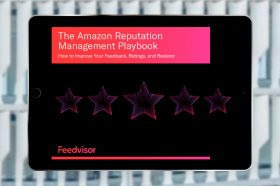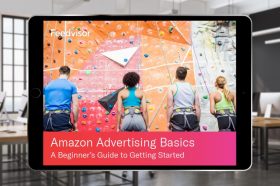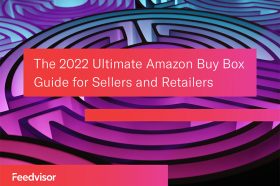Resources - Blog
8 Ways to Fix an Amazon Sales Slump

Stay on top of the latest e-commerce and marketplace trends.
With an increase in competition on Amazon versus previous years, it’s becoming more and more important for third-party sellers to capitalize on every potential sale and differentiate themselves from other sellers on the saturated marketplace.
Although it’s normal for sales to experience slight lifts and drops due to the nature of the constantly changing marketplace, sellers should be proactive to avoid steep sales drop-offs that can dramatically impact their bottom line. We have compiled the top eight solutions to boost Amazon sales, depending on the particular root of the issue.
1. Regain Buy Box Share
The most obvious reason that sellers experience an Amazon sales slowdown is that they have lost ownership of their Buy Box placement. With over 80% of Amazon’s sales funneling through the Buy Box, keeping a close eye on products that vie for the prime positioning should be a frequent, high priority practice for competitive sellers.
There are many variables that affect the Buy Box and certain ones carry more weight with Amazon’s algorithm. With that being said, it’s important to focus on the variables that will make the most difference to your business performance. You can check if you currently have the Buy Box by going to your product listing and seeing if anyone else is trying to fulfill your product. If you see another seller listed below the “Add to Cart” box, then you may have competition that can steal the Buy Box from you. You can also check if you’ve held onto the Buy Box by viewing your account in Seller Central.
2. Understand Your Products’ Seasonality
An essential step to scouting for new products that many sellers omit is researching seasonality trends that may impact a specific item’s sales velocity. A valuable routine to incorporate into your business is tracking monthly, quarterly, and annual sales by SKU so that you can easily identify any seasonal shifts and proactively get ahead of the issue for the next calendar year.
For example, retailers that sell school supplies should expect to see a spike in sales in June and July as customers prepare for back to school and sellers that sell ice melt will be more successful in the winter months and experience a significant sales lag in the summer. All sellers should have ample inventory prior to Prime Day, Black Friday, and the holiday season.
3. Maintain Positive Customer Feedback
Our Amazon User Study 2018: Getting to Know Your Customers eBook revealed that almost 90 percent of Amazon customers would not consider purchasing a product with less than three stars. In addition, 79 percent said that they often check the third-party seller’s rating prior to making a purchase.
Therefore, it’s evident that sellers need to be proactive to avoid receiving poor reviews and seller feedback – as one bad review at the top of a product listing can steer away potential customers or even worse, steer away existing customers from making a repeat purchase. It’s important to be patient, try to fix any mistakes or issues within 24 hours, and monitor reviews regularly.
4. Improve Product Visibility
One of the driving forces behind an Amazon sales decline is that your products just aren’t appearing in searches and aren’t visible across the marketplace. In order to increase sales on Amazon, sellers need to optimize their listings with accurate and attention-grabbing keywords, high-res product images, and clear, relevant product descriptions.
Sellers should strive for their store to appear above the fold on the first page of a search for their products and participate in Amazon PPC ads such as Sponsored Product and Headline Search Ads in order to boost product discoverability to new customers or in a cross-category situation.
5. Keep a Campaign Calendar
It’s important for sellers to set goals internally in order to be able to monitor their performance throughout the year against these goals. However, with so much going on, it’s easy for important dates to fall through the cracks. Another reason behind an Amazon sales drop is a sale or promotion coming to an end without you realizing.
For example, were you running a holiday special with a promotional price on specific items that came to an end on December 31? This could explain why sales were softer in early January. Additionally, if you are running an ad on Facebook or another social media platform that expired, you may notice a decrease in traffic or sales. With that, it’s important for sellers to maintain an internal calendar of all promotions slated for the year in order to stay dialed in to lifts or drops due to promotions and holidays starting or ending.
6. Optimize Your Fulfillment Process
Whether you fulfill your orders via FBA, FBM, SFP, or a mix, it’s important to streamline your fulfillment process to avoid any potential issues for the end user. You should maintain adequate inventory of popular items at all time, as you are more likely to win the Buy Box and maintain customer loyalty this way.
7. Maintain a Healthy Seller Account
Building credibility as a successful Amazon seller is important in helping you improve Amazon sales. You need to show that you have experience with providing good customer service and avoiding shipping and logistical issues. Sellers should check their seller metrics every day in Seller Central and take any necessary steps to maintain healthy order defect rates, cancellation rates, late shipment rates, and customer service dissatisfaction rates. They should focus on the most important performance metrics in order to make an impact on their business’s profitability.
8. Ensure Your Pricing Is Competitive
Price remains the most significant factor of influence for Amazon shoppers. Landed price, which is the total product price plus shipping, is a variable that has a high-impact on Buy Box wins and sellers need to price competitively in order to perform against other sellers who are going to market with similar products. Automating your pricing with a machine-learning solution like Feedvisor’s takes the risk of human error out of the equation and finds the pricing sweet spot for every item in your catalog so that you can focus on your business goals.
Learn what Feedvisor can do for your business.
When you partner with Feedvisor, you automatically receive access to our true, AI-driven technology and hands-on team of e-commerce experts. Contact one of our team members today to learn more about our end-to-end solution for brands and large sellers on Amazon, Walmart, and e-marketplaces.



